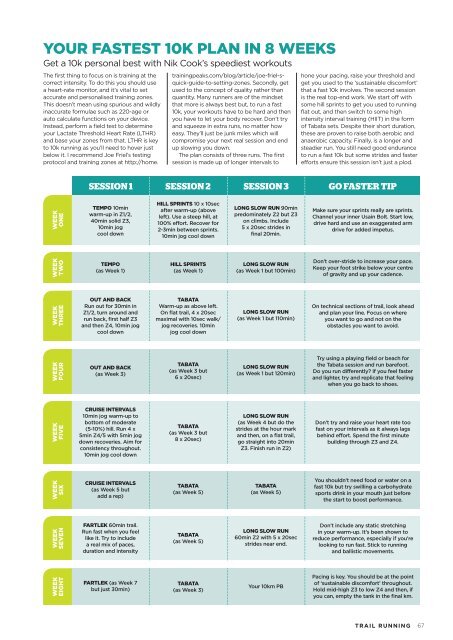Trail Running Oct Nov issue
You also want an ePaper? Increase the reach of your titles
YUMPU automatically turns print PDFs into web optimized ePapers that Google loves.
YOUR FASTEST 10K PLAN IN 8 WEEKS<br />
Get a 10k personal best with Nik Cook’s speediest workouts<br />
The first thing to focus on is training at the<br />
correct intensity. To do this you should use<br />
a heart-rate monitor, and it’s vital to set<br />
accurate and personalised training zones.<br />
This doesn’t mean using spurious and wildly<br />
inaccurate formulae such as 220-age or<br />
auto calculate functions on your device.<br />
Instead, perform a field test to determine<br />
your Lactate Threshold Heart Rate (LTHR)<br />
and base your zones from that. LTHR is key<br />
to 10k running as you’ll need to hover just<br />
below it. I recommend Joe Friel’s testing<br />
protocol and training zones at http://home.<br />
trainingpeaks.com/blog/article/joe-friel-squick-guide-to-setting-zones.<br />
Secondly, get<br />
used to the concept of quality rather than<br />
quantity. Many runners are of the mindset<br />
that more is always best but, to run a fast<br />
10k, your workouts have to be hard and then<br />
you have to let your body recover. Don’t try<br />
and squeeze in extra runs, no matter how<br />
easy. They’ll just be junk miles which will<br />
compromise your next real session and end<br />
up slowing you down.<br />
The plan consists of three runs. The first<br />
session is made up of longer intervals to<br />
hone your pacing, raise your threshold and<br />
get you used to the ‘sustainable discomfort’<br />
that a fast 10k involves. The second session<br />
is the real top-end work. We start off with<br />
some hill sprints to get you used to running<br />
flat out, and then switch to some high<br />
intensity interval training (HIIT) in the form<br />
of Tabata sets. Despite their short duration,<br />
these are proven to raise both aerobic and<br />
anaerobic capacity. Finally, is a longer and<br />
steadier run. You still need good endurance<br />
to run a fast 10k but some strides and faster<br />
efforts ensure this session isn’t just a plod.<br />
SESSION 1<br />
SESSION 2 SESSION 3<br />
GO FASTER TIP<br />
WEEK<br />
ONE<br />
TEMPO 10min<br />
warm-up in Z1/2,<br />
40min solid Z3,<br />
10min jog<br />
cool down<br />
HILL SPRINTS 10 x 10sec<br />
after warm-up (above<br />
left). Use a steep hill, at<br />
100% effort. Recover for<br />
2-3min between sprints.<br />
10min jog cool down<br />
LONG SLOW RUN 90min<br />
predominately Z2 but Z3<br />
on climbs. Include<br />
5 x 20sec strides in<br />
final 20min.<br />
Make sure your sprints really are sprints.<br />
Channel your inner Usain Bolt. Start low,<br />
drive hard and use an exaggerated arm<br />
drive for added impetus.<br />
WEEK<br />
TWO<br />
TEMPO<br />
(as Week 1)<br />
HILL SPRINTS<br />
(as Week 1)<br />
LONG SLOW RUN<br />
(as Week 1 but 100min)<br />
Don’t over-stride to increase your pace.<br />
Keep your foot strike below your centre<br />
of gravity and up your cadence.<br />
WEEK<br />
THREE<br />
OUT AND BACK<br />
Run out for 30min in<br />
Z1/2, turn around and<br />
run back, first half Z3<br />
and then Z4, 10min jog<br />
cool down<br />
TABATA<br />
Warm-up as above left.<br />
On flat trail, 4 x 20sec<br />
maximal with 10sec walk/<br />
jog recoveries. 10min<br />
jog cool down<br />
LONG SLOW RUN<br />
(as Week 1 but 110min)<br />
On technical sections of trail, look ahead<br />
and plan your line. Focus on where<br />
you want to go and not on the<br />
obstacles you want to avoid.<br />
WEEK<br />
FOUR<br />
OUT AND BACK<br />
(as Week 3)<br />
TABATA<br />
(as Week 3 but<br />
6 x 20sec)<br />
LONG SLOW RUN<br />
(as Week 1 but 120min)<br />
Try using a playing field or beach for<br />
the Tabata session and run barefoot.<br />
Do you run differently? If you feel faster<br />
and lighter, try and replicate that feeling<br />
when you go back to shoes.<br />
WEEK<br />
FIVE<br />
CRUISE INTERVALS<br />
10min jog warm-up to<br />
bottom of moderate<br />
(5-10%) hill. Run 4 x<br />
5min Z4/5 with 5min jog<br />
down recoveries. Aim for<br />
consistency throughout.<br />
10min jog cool down<br />
TABATA<br />
(as Week 3 but<br />
8 x 20sec)<br />
LONG SLOW RUN<br />
(as Week 4 but do the<br />
strides at the hour mark<br />
and then, on a flat trail,<br />
go straight into 20min<br />
Z3. Finish run in Z2)<br />
Don’t try and raise your heart rate too<br />
fast on your intervals as it always lags<br />
behind effort. Spend the first minute<br />
building through Z3 and Z4.<br />
WEEK<br />
SIX<br />
CRUISE INTERVALS<br />
(as Week 5 but<br />
add a rep)<br />
TABATA<br />
(as Week 5)<br />
TABATA<br />
(as Week 5)<br />
You shouldn’t need food or water on a<br />
fast 10k but try swilling a carbohydrate<br />
sports drink in your mouth just before<br />
the start to boost performance.<br />
WEEK<br />
SEVEN<br />
FARTLEK 60min trail.<br />
Run fast when you feel<br />
like it. Try to include<br />
a real mix of paces,<br />
duration and intensity<br />
TABATA<br />
(as Week 5)<br />
LONG SLOW RUN<br />
60min Z2 with 5 x 20sec<br />
strides near end.<br />
Don’t include any static stretching<br />
in your warm-up. It’s been shown to<br />
reduce performance, especially if you’re<br />
looking to run fast. Stick to running<br />
and ballistic movements.<br />
WEEK<br />
EIGHT<br />
FARTLEK (as Week 7<br />
but just 30min)<br />
TABATA<br />
(as Week 3)<br />
Your 10km PB<br />
Pacing is key. You should be at the point<br />
of ‘sustainable discomfort’ throughout.<br />
Hold mid-high Z3 to low Z4 and then, if<br />
you can, empty the tank in the final km.<br />
TRAIL RUNNING 67

















